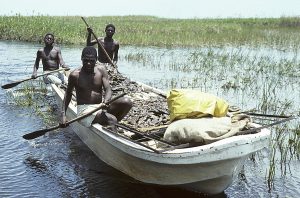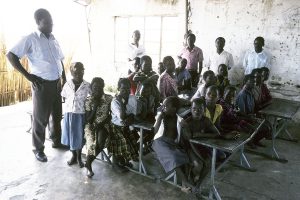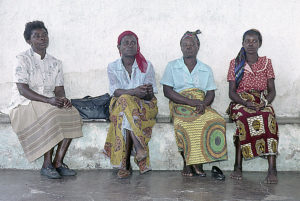Kaj Halberg - writer & photographer
Travels ‐ Landscapes ‐ Wildlife ‐ People
Bangweulu – where water meets the sky

Several years later, in 1873, Livingstone visited the same region, south of the swamps. At this time, his health was in a very poor condition, and in the village of Chitambo he fell sick and died. His intestines were buried under a tree, after which his body was transported to the coast, and from there brought by ship to England. From the road between Serenje and Samfya, c. 10 km north of the turn-off to Kasanka National Park, a sign indicates the way to Chitambo. A memorial has been erected near the tree, where Livingstone’s intestines were buried. It can be visited for a small fee, payable to the local chief in the village of Chitambo.

The climate in this area is tropical, with three seasons. The rainy season, amainsa, is between November and April, with an annual precipitation of c. 1,200 mm, followed by the cold dry season, umupepo, between May and August. In July, the day temperature is usually around 15oC, and nights can be very cold, occasionally near the freezing point. The hot dry season, ulusuba, in September-October, has temperatures up to 35oC.
The water level of the Bangweulu Swamps is very low, in most places below 3 m. The rivers from the surrounding hills bring a huge amount of eroded material into the swamps, and where it is deposited, the river channels often change their course. Along the banks are dense growths of tall water plants, especially papyrus (Cyperus papyrus) and reed (Phragmites australis). Other areas have a lower vegetation, including species of club-rush (Schoenoplectus and/or Scirpus), arrowhead (Sagittaria), and various composites.
On their way across the marshlands, the river channels form countless shallow lakes, their surface often covered by a carpet of floating plants, such as blue waterlily (Nymphaea caerulea), which has bluish or reddish flowers, Indian water-snowflake (Nymphoides indica), of the bog-bean family (Menyanthaceae), with white flowers, and yellow ottelia (Ottelia ulvifolia), of the frogbit family (Hydrocharitaceae), which has yellow flowers.
Most of the few larger islands in the swamps consist of sand, deposited by the river channels. Other islands, called chulu, are established around termite mounds. Formerly, this region was drier, with thousands of termite mounds – today a common sight in the grasslands, bordering the marshes, which are only submerged a few months a year. Livingstone referred to the Bangweulu Swamps as ’a world of water and termite mounds’.
As termites concentrate and transform organic material around their mounds, the immediate surroundings are more fertile than the land around them. Therefore, many plant species, which require a higher content of nutrients, often grow on or around these mounds. During the rainy season, much eroded material is deposited around the mounds, and, over time, trees grow up around them, forming small woods, called mushitu. Trees in these woods include Syzygium cordatum, sausage tree (Kigelia africana), and various fig species (Ficus). On almost all islands in the swamps, these mushitu woods have been felled, replaced by exotic trees like eucalyptus, which are utilized as timber and firewood.
Even though c. 90% of the precipitation evaporates in the strong sunshine, the remaining 10% is enough to make the water level rise about 1 m during the rainy season. As the Great Bangweulu Basin is so flat, the water line may move as much as 45 km inland, when the water level is at its highest. This area, which is submerged part of the year, is mainly covered in grasses. These grasslands rise almost imperceptibly away from the swamps, merging into miombo woodland, a very open forest type, dominated by the genera Julbernardia and Brachystegia.
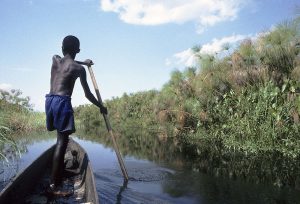
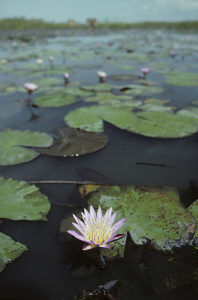
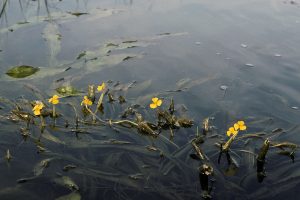
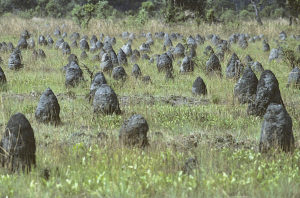
Almost as large is the hippo (Hippopotamus amphibius), whose Latin name is from the Greek hippos (‘horse’), potamos (‘river’), amfi (‘both sides’), and bios (‘life’), thus ‘the river horse that lives on both sides’, i.e. in water as well as on land. These enormous animals, up to 3.5 m long and weighing up to 3 tonnes, spend most of their time partly submerged, or basking on the river banks, going ashore at night to graze. Their skin excretes a reddish fluid, which protects the skin against being burned by the sun. A widespread belief in the old days was that hippos were sweating blood! – Hippos are described in depth on the page Animals: Hippo – the river horse that lives on both sides.
The Zambezi sitatunga (Tragelaphus spekii ssp. selousi) is an antelope, whose very long hooves can be widely splayed, an adaptation to run in wet or swampy areas without sinking in. The male is slate-coloured, while the female is a beautiful reddish-brown, and both sexes have pale vertical stripes on their body. Only the male has horns, which are rather short and slightly spiralled. The sitatunga is an excellent swimmer, and when in danger it may dive, lying submerged with only its nostrils above the surface.
The black lechwe (Kobus lechwe ssp. smithemani) is confined to the Bangweulu Basin. The long, gracefully arched horns of the male are ribbed, whereas the female has no horns. Following the rainy season, when the water recedes from the flooded areas around the swamps, fresh grass will sprout. At this time, large numbers of lechwe frequent these areas to graze. In former times, hundreds of thousands of these magnificent antelope roamed the grasslands, but their numbers have shrunk drastically due to uncontrolled hunting, and today there may be as few as 30,000 individuals.
The grasslands are home to three other species of antelope. The southern reedbuck (Redunca arundinum) has black markings on its front legs, and its rather short, arched horns have a whitish base. This species is found in the transition zone between the grasslands and the swamps proper. The size of their territory varies according to the seasons, being smaller when the water level rises during the rainy season, and larger when it recedes during the dry season. The stocky tsessebe (Damaliscus lunatus), which is dark brown with a darker face and greyish thighs, often keeps a lookout from the top of termite mounds. The third antelope is the yellowish-brown, long-necked oribi (Ourebia ourebi ssp. hastata), which lives singly or in family groups. – Many other types of antelope are described on the page Animals: Antelopes.
At times, stray leopards (Panthera pardus) and hunting dogs (Lycaon pictus) are a threat to these antelopes, but their chief predator, the lion (Panthera leo), has been exterminated in the swamps. The massive buffalo (Syncerus caffer) occasionally visits the marshland, mostly frequenting the surrounding grassland, where huge herds may be observed.
Most plant-eating birds in these swamps are members of the duck family. Larger or smaller flocks of white-faced whistling-ducks (Dendrocygna viduata), fulvous whistling-ducks (D. bicolor), comb ducks (Sarkidiornis melanotos), spur-winged geese (Plectropterus gambensis), and pygmy geese (Nettapus auritus) forage on water plants in lakes and river channels.
Lesser herbivores like insects, snails, fish, and turtles are rarely observed, but due to their enormous numbers, they transform a much larger biomass than the larger herbivores.
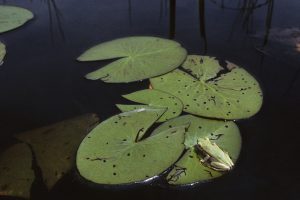

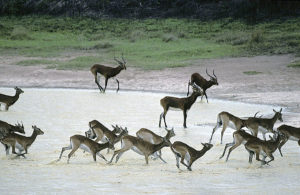
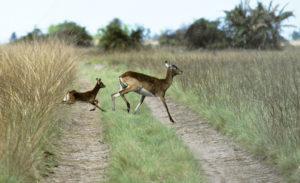

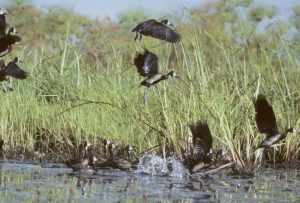
The abundant insect life gives nourishment to other animals like prawns, fish, frogs, and smaller birds. No less than 67 species of fishes have been encountered, many of which, however, are declining due to overfishing. Higher in the food chain are various animals, including turtles, snakes, Nile crocodile (Crocodylus niloticus), various birds, and two otter species, African clawless otter (Aonyx capensis) and spot-necked otter (Lutra maculicollis).
The Nile crocodile is fairly common in the marshes. This animal mainly preys on fish and antelope, but large specimens, 5-6 m long, often become much feared maneaters. The victims are mainly bathing children, or women washing clothes in the lake or along the river channels. Another reptile is the Nile monitor (Varanus niloticus), which grows to 1.5 m long. The major part of its food is fish and frogs, but it also takes bird eggs and young.

The pink-backed pelican (Pelecanus rufescens) is widespread in sub-Saharan Africa, and is also found along the west coast of the Arabian Peninsula. This species has a predominantly grey plumage, but the rump is pink, hence its name. It is fairly common in the swamps.
The large wattled crane (Bugeranus carunculatus) is distributed from Angola, Zaire, and Tanzania southwards to South Africa, with an isolated occurrence in the highlands of Ethiopia. Usually, the female lays only one egg, and following a rainy season with scanty rainfall it will not breed at all. For these reasons, its reproduction rate is very slow, making it most sensitive to habitat destruction, such as draining of marshes and construction of river dams. This magnificent bird is declining in almost its entire area of distribution, and as few as 8,000 to 9,000 birds may remain. In the Bangweulu Swamps, it is widely distributed, but in low numbers.
Other resident birds include African spoonbill (Platalea alba), sacred ibis (Threskiornis aethiopicus), goliath heron (Ardea goliath), slaty egret (Egretta vinaceigula), and the peculiar black heron (Egretta ardesiaca), which raises its wings over its head like an umbrella, luring fish into the cooler shade beneath the bird.
Various raptors, mainly Montagu’s harrier (Circus pygargus), pallid harrier (C. macrourus), and African marsh harrier (C. ranivorus), patrol the plains in search of weakened animals, whereas pied crows (Corvus albus) and yellow-billed kites (Milvus parasitus) are mostly seen around human habitation, where they feed on garbage, or occasionally steal fish from drying-racks.
Birds like African reed warbler (Acrocephalus baeticatus), swamp flycatcher (Muscicapa aquatica), marsh tchagra (Bocagia minuta), and coppery-tailed coucal (Centropus cupreicaudus) often feed among tall swamp plants, whereas blue-tailed bee-eaters (Merops persicus) and olive bee-eaters (M. superciliosus) swoop out from their perch to snap dragonflies or bees.
The inundation of the surrounding grasslands during the rainy season causes an abundance of fish fry, snails, prawns, insects, and other small creatures to hatch in the shallow water, providing food for huge flocks of waders from the Northern Hemisphere, which spend the winter here, including ruff (Calidris pugnax), greenshank (Tringa nebularia), marsh sandpiper (Tringa stagnatilis), wood sandpiper (T. glareola), and collared pratincole (Glareola pratincola).
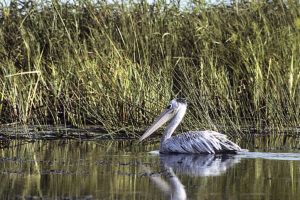

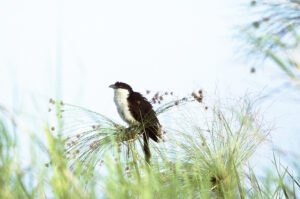
Several hundred years ago, large bands of Bantu people started emigrating east and south from their home in Nigeria and the Congo River Basin. The word bantu is from ba (’several’) and ntu (’human’), thus ‘people’. Slowly, these Bantu tribes spread east and south, over time colonizing the entire southern half of Africa, expelling the aboriginal peoples to more remote areas.
One Bantu people, the Unga, arrived at the Bangweulu Swamps in the 1700s. In this marshland, they encountered a hunter-and-gatherer people, whom they called Ba-twa (’the wild people’). These Ba-twa were living in temporary shelters, their food consisting of rhizomes of water-lilies (masanga), papyrus roots (luko), and a number of other wild plants, besides fish, birds, and antelope. The Unga settled on islands in these vast swamps, where fish and game were abundant. Over time, they mingled with the Ba-twa, and the language and culture of these aboriginals have disappeared. Today, all people in the swamps call themselves Unga, speaking the same Bemba language.
The Unga society is matrilineal, which means that you trace your descent through your mother’s lineage. In former times, a newly married man would move to his wife’s village, making it possible for her to stay with her family. This pattern, however, has changed, and today the men dominate the women. Polygyny (having more than one wife) is common, and a man may have a wife on several of the islands. An Unga woman never has more than one husband.
Traditionally, the Unga marry at a young age, the girls at 15 or 16, the boys at 18 or 19. Formerly, it was not unusual to encounter mothers, who were only 14 years old. Marriage is a very simple matter. The boy just moves to the girl’s family, or sometimes vice versa. Most families are extended families, comprising for example two sisters and their husbands and children, living together with the wives’ parents.
In daily life, the chief is the head of the village, or several villages within a specific area. When a chief has passed away, his post is inherited by one of his daughters’ sons, who is elected by the people. The chief is paid by the government. His job is to distribute the right to use arable land and fishing waters. As a rule, his decisions are respected, and villagers also often contact him and the village elders regarding various problems. Two men might dispute, who was the first to spot a particularly good fishing water, or a woman might complain that her husband is spending money that she has earned, to buy alcohol.
There is a sharp division of labour between the sexes. The men go fishing part of the year, they build houses, and they also construct canoes, which are carved from a tree trunk. Few can afford to buy a so-called banana boat – a fibre glass boat, the shape of which somewhat resembles a banana. A few of the Unga are skilled labourers. The women do the housework, including cooking, and also tend the fields. When fields are prepared for planting, the men assist them, as this is very hard work. Children start working at an early age.
All Unga men wear European style dress. The women have adopted the European frock, but as a rule they also wear a gaily coloured cloth, about 2 x 1 m, called a chitenge. Babies are always carried in a chitenge on the back of their mother, or grandmother, or sister, no matter what they are doing.
Larger villages in the marshland have a shop and a school, and the teacher lives on the island. A few places have primitive clinics. Seriously ill persons must be transported to the hospital in Samfya, often a journey of several days by canoe.
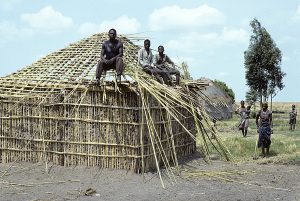
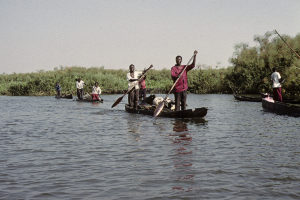
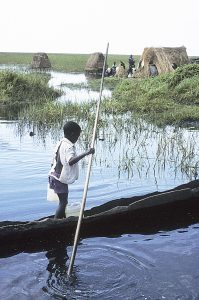
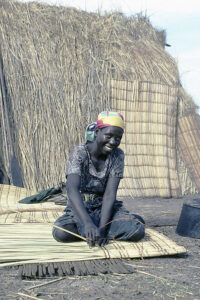
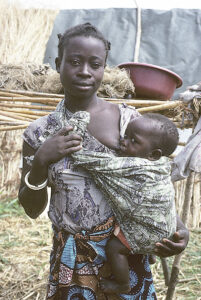
However, even the modern Unga firmly believe in spirits and witches. If a person suddenly falls ill or dies, or if a village is haunted by bad luck, this must be caused by an evil spirit or a witch. To be declared a witch is a very serious matter, and the person in question, man or woman, is sometimes expelled from the village. If a death is not caused by a witch, a so-called man-crocodile could be the cause – a dangerous double-being, which, simultaneously, lives as a crocodile and a human being. If a person dies at the same time as a crocodile is killed, this person is considered to be a man-crocodile.
Unga society is permeated by taboos. For instance, if a man is sleeping with another woman, while his wife is pregnant, he is blamed if the child dies. Certain food items are forbidden for pregnant women to eat. Theft can be prevented by attaching a witchcraft charm onto valuable items, such as canoes and crops. They are now as securely protected, as they would be under lock and key.
Death is a very important event, and the entire family will attend the funeral, coming from near and far. A widow or a widower is allowed to marry again. However, before this can take place, she or he must undergo a cleansing ritual by sleeping with a relative of the deceased.

Cassava is a very hardy plant, which can grow in the sandy and infertile soil on the islands in the swamps. It is propagated by simply cutting stems into smaller pieces and sticking them into the soil. Cassava is cultivated on small, raised mounds to keep the tubers above the high water level in the swamps, to prevent them from rotting. When these mounds lie fallow after the harvest, they are quickly overgrown by grasses and other plants. This turf must be turned over, before planting of cassava can take place. This hard work is done by men as well as women, hoes being their only tool. The turf is the only means of fertilizer, as the Unga cannot afford chemical fertilizers, and they possess very few domestic animals to provide dung. Thus, the yield is very low due to the infertile soil. Another huge problem is wax scales, which suck juice of the plants, causing many of them to wither.
The soil must lie fallow for two to three years between each harvest. The tubers are dug up after only one growing season, as they will otherwise rot during the rainy season. For this reason, the plants do not get sufficient time to develop cuttings for the next season, and these must be bought on the mainland.
Nshima is a kind of porridge, made from cassava tubers. Preparing nshima is a very long and laborious process, lasting 7 to 10 days. The women dig up the tubers and carry them to the village, where they are pealed and cut into small pieces, which are spread out to dry in the sun. They are then soaked in water for a day to extract toxic cyanides. The wet cassava ferments for a couple of days and is then mixed with cassava flour from the previous preparation. This mixture is pounded and left to ferment for another day, then pounded again and left to dry in the sun for yet another day. At last it is pounded into flour, which is boiled to make nshima. It is eaten with your fingers, usually with fried fish and a bit of green, sometimes from wild plants.
The Unga also grow a few other crops, including sweet potatoes (Ipomoea batatas), beans, maize, and pumpkins, but the yield is small due to the poor soil. As they cannot afford fertilizer, the Unga cut grasses and other wild plants to be used as fertilizer. Some Unga have tried to grow rice, but, unfortunately, preparing the paddy fields coincides with the fishing season, so a woman growing rice cannot join her husband to a fishing camp (described in the following paragraph). Very little rice is cultivated in the swamps, as most women prefer to go to these fishing camps. Furthermore, rice fields must be weeded more often than cassava fields, and ripening rice plants must be guarded against birds, hippos, and other animals, which do not eat cassava plants.
The Unga have very few domestic animals, only chickens and ducks, besides dogs. In former times, they also had goats and cattle, but as the water level in the swamps was rising over a number of years, all available soil had to be cultivated, and nothing was left over as pastures. Sometimes hunters bring antelope meat, or wild geese or ducks, to sell to the villagers. The fact that many of these animals have been shot illegally, doesn’t seem to bother anybody.
In the old days, when the swamps were teeming with black lechwe, the village chiefs would arrange an annual hunt. However, following World War One, firearms became more widespread, and far too many lechwe were shot. Today, there may be as few as 30,000, and government authorities have established wildlife sanctuaries in the swamps for them. To shoot a lechwe or a sitatunga requires a permit, and you must pay a fee to the government. As the Unga have always hunted these animals, they consider this requirement unfair, and for this reason poaching is widespread.
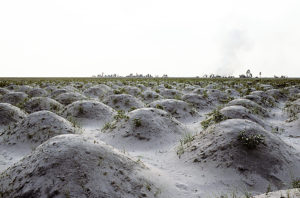

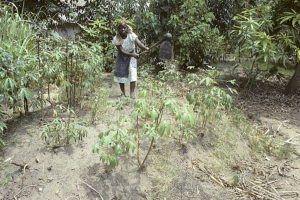
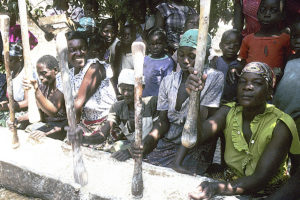
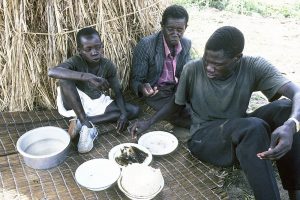
Now it is time to go fishing, and most Unga families move from their village to stay in fishing camps in the interior of the swamps. In August, the father will leave alone, bringing only fishing nets and a few necessary items for a month’s stay. On a tiny island, he builds a simple grass hut, made of branches and reeds. This way of construction, however, allows the wind to pass through the walls, keeping the interior wonderfully cool. At one end of the hut is a tiny kitchen, and the remainder is bedroom for the entire family. At night, the door and the small window openings are covered by sacks, to protect the sleeping family members against mosquitoes.
About a month later, the rest of the family will join the father. The canoes are paddled by larger boys, while their mother and siblings keep track of household items, clothes, soap, cassava and maize flour, chickens, ducks, dogs, and whatever else they may need for a two months’ stay.
In the fishing camp, people get up at dawn. Men and older boys paddle their canoe to empty the fishing nets, which were erected the night before. Each net is about 50 m long, and on average, each family needs about ten nets to make a living. In former times, nets were made from plant fibres, or from thin metal strings from old car tyres, but today almost all nets are made from nylon, which is far more durable. Before removing a fish from the net, the fisherman stuns it with a blow from a stick, to make sure that it won’t be able to jump out of the canoe. While men and boys are out emptying the nets, women and larger girls are busy in the camp, cleaning the hut, preparing breakfast, nursing babies, weaving mats, etc. Fish, which were caught the previous afternoon, are gutted and placed on mats to dry. Some of the fish are smoked in a special smoke hut, in which wet plants are placed on a fire to produce a heavy smoke.
When husband and sons return, the entire family eats breakfast: fish and nshima, often with edible wild plants from the swamps. The morning catch is gutted and placed on mats to dry, while nets are spread out to dry in the sun. Some may be damaged and need to be mended.
During the hot midday hours, the children swim and play in the shallow water. Before building his hut, the father makes sure that there are no large crocodiles in the area. In the afternoon, men and boys again go out fishing. They beat the water surface to scare fish into the nets. This method is in fact illegal, but nobody cares. Some fishermen use hooks, while others stretch out nets between two river banks, pulling the nets along the river channel. This method is also illegal.
At dusk, men and boys are back in the camp, where they are served the evening meal. Afterwards the family members can relax for a while, but the mosquitoes soon become a nuisance, so everyone goes to bed early.
In later years, people from the mainland go fishing in the swamps in ever increasing numbers, which adds greatly to the overfishing that already takes place. Zambian farmers often have to wait for many months to be paid by the government for their crops, and when they are finally paid, the galopping inflation has often eaten much of their profit. To sell fish is a much faster and easier way of making money. To be permitted to fish, mainlanders must pay a fee to the local Unga chief.
In the grasslands bordering the swamps, people often build long weirs, with a few openings, which can be blocked when the water is receding, making it very easy to catch the fish, which cannot escape. This method is highly destructive, as many fish, which have gathered in the shallow waters to lay eggs, are also caught, as well as fish fry. Naturally, these various forms of overfishing have caused numerous fish species to decline drastically.
Firewood is scarce in the marshland. Papyrus and dry grass can be used, but wood is far better. As almost all trees in the mushitu woods have been felled, firewood must be acquired from the mainland. For this reason, numerous boats are paddled ashore, laden with fish, which are exchanged for firewood.


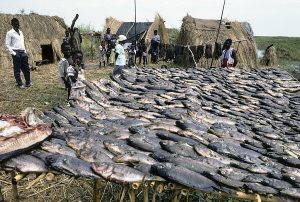
This is the leisure time for the Unga. Maybe a new grass roof is needed on your house, or holes in it must be repaired. Fishing nets are mended and prepared for the next fishing season. Once in a while, the father paddles his canoe, laden with dried fish, to the mainland, where he will exchange them for necessities such as maize flour, salt, soap, clothes, and batteries. On his way, he may encounter tradesmen on their way out into the swamps, thus avoiding to make the rest of the trip.
In their leisure time, Unga men love to sit in groups, talking and drinking alcohol. Some women, especially widows, make good money making and distributing local alcohol. Superior business days for them are Sundays after church service, and at funerals and weddings.
For the children, this is time to go to school. Most children attending school are boys, as almost all the girls must stay with their mother to take part in the house work and work in the fields. The Unga do not regard school education as very important – after all, you are just going to become a fisherman or a house wife. Education of girls, especially, is not important, as they are going to marry at an early age. A scanty knowledge of reading, writing, and calculation must suffice.
Attending school is expensive, as you must pay for books and utensils, and also contribute to the maintenance of the school building. Most Unga cannot afford this, causing most of the school buildings to be in a very poor condition. During the rainy season, en entire wall will sometimes collapse. Often there are not enough tables and chairs for the students, and as only a few of the children have books, the teacher will say something, which the pupils then repeat by shouting in chorus, or the teacher writes a sentence on the blackboard, which the kids duplicate. Very few Unga children complete a higher education.
Naturally, most Unga want a higher standard of living. However, the only means of payment they possess is fish, which means that if you want a little more than just the bare necessities, you must catch more fish. To do this, many Unga have acquired fishing nets with smaller mesh (down to 3 cm), and they fish for longer periods of time. This is destructive to the already harassed fish populations, and only worsens the problem. Fewer fish grow to breeding size, and the amount of fish fry is diminishing.
As mentioned above, the government has prohibited fishing between December and February, and certain fishing methods are not permitted. All prohibitions, however, are violated, and control from the authorities is scanty in the remote swamps. The Unga have entered a vicious circle, which keeps them in poverty, causing many young men to leave the swamps to gain a higher standard of living. The cities on the mainland, however, hold many other dangers, which were formerly unknown in the marshes, such as a high level of crime, and life-threatening diseases like aids.
In the 1990s, Verdensnaturfonden, the Danish section of WWF (Worldwide Fund for Nature), made a huge effort to help the Unga to a better standard of living through the foundation of local councils, called Community Development Units. Several women’s groups were also formed, teaching women about healthy food, hygiene, care of infants, knitting, sewing, and baking, and about women’s rights in Zambia.
